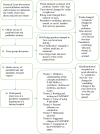Adaptation and content validation of measure yourself medical outcomes profile (MYMOP) for 7-11 year-old children
- PMID: 38874698
- PMCID: PMC11390820
- DOI: 10.1007/s11136-024-03702-3
Adaptation and content validation of measure yourself medical outcomes profile (MYMOP) for 7-11 year-old children
Abstract
Background: The Measure Yourself Medical Outcome Profile (MYMOP) is an individualised tool designed for adults but used with children without any evidence of validation in this population. Individualised instruments are patient-specific rather than disease-specific and therefore can be applied across various health conditions. This study sought to adapt, and content validate the MYMOP for application in 7-11 year old children.
Methods: There were two main phases of the four iterations: expert consultation (three rounds) and interviews with child-parent pairs at the Outpatient clinics of a Children's Hospital. Thematic analysis was undertaken using an inductive, interpretative approach.
Results: Four paediatricians completed the first survey, five paediatricians participated in the focus group, and four paediatric health-related quality of life (HRQOL) research experts completed the second survey. Several changes were recommended to the MYMOP by the expert groups. Twenty-five children (17 general medicine, and 8 diabetes/endocrine clinic) aged 7-11 years completed the draft paediatric MYMOP (P-MYMOP) and were interviewed. Results demonstrated that the majority of participants were able to identify their own problems and activity limitations, and all participants understood the 7-point faces scale. Most parents and children perceived that the P-MYMOP would be useful to complete before clinic appointments.
Conclusions: The P-MYMOP is the first content-validated generic individualised HRQOL measure for children 7-11 years old. Given that validation is an iterative process, further research to assess its feasibility, reliability, and construct validity is required.
Keywords: Health related quality of life; Individualised; MYMOP; Paediatric MYMOP; Patient centred outcomes.
© 2024. The Author(s).
Conflict of interest statement
All authors declare that there are no financial or other competing interests.
Figures
Similar articles
-
Developing and Validating the Latin-American Spanish Version of the Measure Yourself Medical Outcome Profile® (MYMOP-LAS).Am J Occup Ther. 2025 May 1;79(3):7903205020. doi: 10.5014/ajot.2025.051021. Am J Occup Ther. 2025. PMID: 40293951
-
In pursuit of patient-centred outcomes: a qualitative evaluation of the 'Measure Yourself Medical Outcome Profile'.J Health Serv Res Policy. 2000 Jan;5(1):27-36. doi: 10.1177/135581960000500108. J Health Serv Res Policy. 2000. PMID: 10787584
-
A brief patient-reported outcome instrument for primary care: German translation and validation of the Measure Yourself Medical Outcome Profile (MYMOP).Health Qual Life Outcomes. 2014 Jul 19;12(1):112. doi: 10.1186/s12955-014-0112-5. Health Qual Life Outcomes. 2014. PMID: 25927343 Free PMC article.
-
Individualized health-related quality of life instrument Measure Yourself Medical Outcome Profile (MYMOP) and its adaptations: a critical appraisal.Qual Life Res. 2019 Apr;28(4):879-893. doi: 10.1007/s11136-018-2046-6. Epub 2018 Nov 13. Qual Life Res. 2019. PMID: 30426277 Review.
-
[Measuring Instruments of the Quality of Life Pediatric Palliative Care].Acta Med Port. 2015 Jul-Aug;28(4):501-12. Epub 2015 Aug 31. Acta Med Port. 2015. PMID: 26574987 Review. Portuguese.
Cited by
-
Systematic Review of Conceptual, Age, Measurement and Valuation Considerations for Generic Multidimensional Childhood Patient-Reported Outcome Measures.Pharmacoeconomics. 2022 Apr;40(4):379-431. doi: 10.1007/s40273-021-01128-0. Epub 2022 Jan 24. Pharmacoeconomics. 2022. PMID: 35072935 Free PMC article.
References
-
- Clinch, J., Tugwell, P., Wells, G., & Shea, B. (2001). Individualized functional priority approach to the assessment of health-related quality of life in rheumatology. Journal of Rheumatology,28(2), 445–451. - PubMed
-
- Mayo, N. E., Aburub, A., Brouillette, M. J., Kuspinar, A., Moriello, C., Rodriguez, A. M., et al. (2017). In support of an individualized approach to assessing quality of life: Comparison between patient generated index and standardized measures across four health conditions. Quality of Life Research,26(3), 601–609. 10.1007/s11136-016-1480-6 - DOI - PubMed
Publication types
MeSH terms
LinkOut - more resources
Full Text Sources



